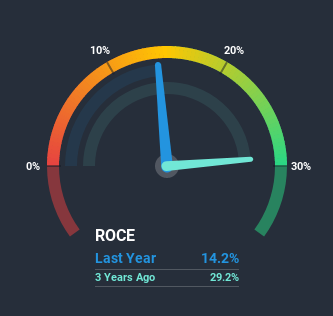Here's What To Make Of Tasty Bite Eatables' (NSE:TASTYBITE) Returns On Capital

If we want to find a stock that could multiply over the long term, what are the underlying trends we should look for? Amongst other things, we'll want to see two things; firstly, a growing return on capital employed (ROCE) and secondly, an expansion in the company's amount of capital employed. Put simply, these types of businesses are compounding machines, meaning they are continually reinvesting their earnings at ever-higher rates of return. In light of that, when we looked at Tasty Bite Eatables (NSE:TASTYBITE) and its ROCE trend, we weren't exactly thrilled.
Return On Capital Employed (ROCE): What is it?
For those that aren't sure what ROCE is, it measures the amount of pre-tax profits a company can generate from the capital employed in its business. The formula for this calculation on Tasty Bite Eatables is:
Return on Capital Employed = Earnings Before Interest and Tax (EBIT) ÷ (Total Assets - Current Liabilities)
0.14 = ₹301m ÷ (₹3.1b - ₹983m) (Based on the trailing twelve months to December 2020).
Thus, Tasty Bite Eatables has an ROCE of 14%. That's a relatively normal return on capital, and it's around the 12% generated by the Food industry.
See our latest analysis for Tasty Bite Eatables

While the past is not representative of the future, it can be helpful to know how a company has performed historically, which is why we have this chart above. If you're interested in investigating Tasty Bite Eatables' past further, check out this free graph of past earnings, revenue and cash flow.
What The Trend Of ROCE Can Tell Us
On the surface, the trend of ROCE at Tasty Bite Eatables doesn't inspire confidence. To be more specific, ROCE has fallen from 29% over the last five years. Meanwhile, the business is utilizing more capital but this hasn't moved the needle much in terms of sales in the past 12 months, so this could reflect longer term investments. It may take some time before the company starts to see any change in earnings from these investments.
The Key Takeaway
To conclude, we've found that Tasty Bite Eatables is reinvesting in the business, but returns have been falling. Since the stock has gained an impressive 89% over the last three years, investors must think there's better things to come. However, unless these underlying trends turn more positive, we wouldn't get our hopes up too high.
Tasty Bite Eatables does have some risks though, and we've spotted 1 warning sign for Tasty Bite Eatables that you might be interested in.
While Tasty Bite Eatables isn't earning the highest return, check out this free list of companies that are earning high returns on equity with solid balance sheets.
When trading Tasty Bite Eatables or any other investment, use the platform considered by many to be the Professional's Gateway to the Worlds Market, Interactive Brokers. You get the lowest-cost* trading on stocks, options, futures, forex, bonds and funds worldwide from a single integrated account. Promoted
Valuation is complex, but we're here to simplify it.
Discover if Tasty Bite Eatables might be undervalued or overvalued with our detailed analysis, featuring fair value estimates, potential risks, dividends, insider trades, and its financial condition.
Access Free AnalysisThis article by Simply Wall St is general in nature. It does not constitute a recommendation to buy or sell any stock, and does not take account of your objectives, or your financial situation. We aim to bring you long-term focused analysis driven by fundamental data. Note that our analysis may not factor in the latest price-sensitive company announcements or qualitative material. Simply Wall St has no position in any stocks mentioned.
*Interactive Brokers Rated Lowest Cost Broker by StockBrokers.com Annual Online Review 2020
Have feedback on this article? Concerned about the content? Get in touch with us directly. Alternatively, email editorial-team (at) simplywallst.com.
About NSEI:TASTYBITE
Tasty Bite Eatables
Manufactures and sells prepared foods in India and internationally.
Flawless balance sheet very low.
Similar Companies
Market Insights
Community Narratives



